Related Research Articles
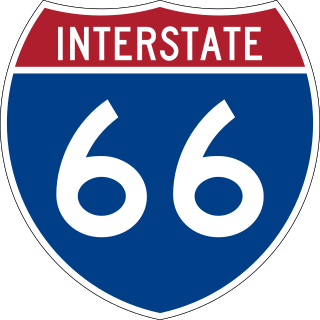
Interstate 66 (I-66) is an Interstate Highway in the eastern United States. As indicated by its even route number, it runs in an east–west direction. Its western terminus is near Middletown, Virginia, at an interchange with I-81; its eastern terminus is in Washington, D.C., at an interchange with U.S. Route 29 (US 29). Much of the route parallels US 29 or State Route 55 (SR 55). I-66 has no physical or historical connection to the famous US 66, which was located in a different region of the United States.
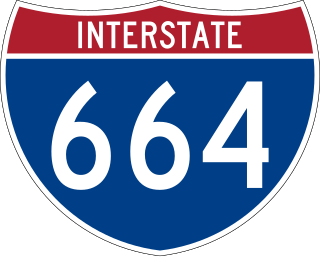
Interstate 664 (I-664) is an auxiliary Interstate Highway in the US state of Virginia. The Interstate runs 20.79 miles (33.46 km) from I-64 and I-264 in Chesapeake north to I-64 in Hampton. I-664 forms the west side of the Hampton Roads Beltway, a circumferential highway serving the Hampton Roads metropolitan area. The Interstate crosses Hampton Roads via the Monitor–Merrimac Memorial Bridge–Tunnel (MMMBT) between Suffolk and Newport News. I-664 is connected to the other major cities of the metropolitan area—Portsmouth, Norfolk, and Virginia Beach—by I-264. The Interstate also has a connection to Portsmouth through State Route 164 (SR 164) and to Suffolk via U.S. Route 13 (US 13), US 58, and US 460.

The Hampton Roads Bridge–Tunnel (HRBT) is a 3.5-mile (5.6 km)-long Hampton Roads crossing for Interstate 64 and U.S. Route 60. It is a four-lane facility comprising bridges, trestles, man-made islands, and tunnels under the main shipping channels for Hampton Roads harbor in the southeastern portion of Virginia in the United States.
The Hampton Roads Beltway is a loop of Interstate 64 and Interstate 664, which links the communities of the Virginia Peninsula and South Hampton Roads which surround the body of water known as Hampton Roads and comprise much of the region of the same name in the southeastern portion of Virginia in the United States. It crosses the harbor of Hampton Roads at two locations on large four-laned bridge-tunnel facilities: the eastern half carries Interstate 64 and uses the Hampton Roads Bridge-Tunnel and the western half carries Interstate 664 and uses the Monitor-Merrimac Memorial Bridge-Tunnel. The beltway has the clockwise direction signed as the Inner Loop, and the counter-clockwise direction signed as the Outer Loop. The entire beltway, including the bridge-tunnels, is owned and operated by the Virginia Department of Transportation.
The Virginia Department of Transportation (VDOT) is the agency of the state government responsible for transportation in the state of Virginia in the United States. VDOT is headquartered at the Virginia Department of Highways Building in downtown Richmond. VDOT is responsible for building, maintaining, and operating the roads, bridges, and tunnels in the commonwealth. It is overseen by the Commonwealth Transportation Board, which has the power to fund airports, seaports, rail, and public transportation.
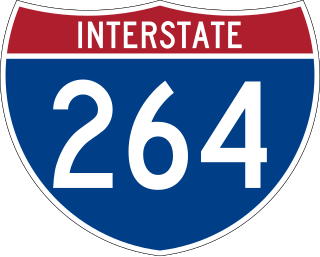
Interstate 264 (I-264) is an Interstate Highway in the US state of Virginia. It serves as the primary east–west highway through the South Hampton Roads region in southeastern Virginia. The route connects the central business districts of Chesapeake, Portsmouth, Norfolk, and Virginia Beach and serves as the most direct link between those cities and the resort beaches along Virginia's Atlantic coast.

The Interstate 264 Berkley Bridge is a double-leaf bascule bridge that crosses the Eastern Branch of the Elizabeth River in Norfolk, Virginia, United States. It carries Interstate 264 (I-264), U.S. Route 460 Alternate, and State Route 337 (SR 337) across the river, connecting the Berkley neighborhood south of the river with downtown Norfolk to the north. The toll-free facility is one of only a small number of movable bridges on the Interstate Highway System, and is the first of two in the Hampton Roads region, predating the High Rise Bridge. It is named for the former Town of Berkley that is now a part of the City of Norfolk.

The Downtown Tunnel on Interstate 264 (I-264) and U.S. Route 460 Alternate crosses the Southern Branch of the Elizabeth River in the South Hampton Roads area of Virginia, US. It links the independent City of Portsmouth with the independent City of Norfolk. In conjunction with the Berkley Bridge, the Downtown Tunnel connects to Interstate 464 to the City of Chesapeake and a continuation I-264 to the downtown and Waterside areas of Norfolk, and on to Virginia Beach. Owned by the Virginia Department of Transportation (VDOT), it is operated and maintained by Elizabeth River Crossings under a 58-year public–private partnership concession agreement. Formerly a toll-free facility, open road tolling was implemented on February 1, 2014 by VDOT to help finance repairs and expansion to the tunnel.

The Midtown Tunnel carries U.S. Highway 58 across the Southern Branch of the Elizabeth River in the South Hampton Roads area of Virginia, US. It links the cities of Portsmouth and Norfolk. Owned by the Virginia Department of Transportation (VDOT), it is operated and maintained by Elizabeth River Crossings under a 58-year public–private partnership concession agreement. Formerly a toll-free facility, open road tolling was implemented on February 1, 2014 by VDOT to help finance repairs and expansion to the tunnel.
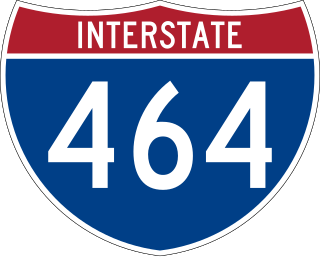
Interstate 464 (I-464) is an Interstate Highway in the US state of Virginia. The highway runs 5.67 miles (9.12 km) from U.S. Route 17 (US 17) and State Route 168 (SR 168) in Chesapeake north to I-264 in Norfolk. I-464 connects two major highway junctions in the South Hampton Roads region. At its southern end, the Interstate meets two major highways that head toward North Carolina, US 17 and SR 168, and I-64, which follows the southern side of the Hampton Roads Beltway. At its northern terminus, I-464 has connections with Downtown Norfolk and Portsmouth via I-264.

Interstate 564 (I-564) is an Interstate Highway in the US state of Virginia. Known as Admiral Taussig Boulevard, after US Navy Rear Admiral Edward D. Taussig, the Interstate runs 3.03 miles (4.88 km) from State Route 337 (SR 337) east to I-64 within the city of Norfolk. I-564 is the primary access highway to Naval Station Norfolk, the world's largest naval base. The Interstate also links I-64 with Norfolk International Terminals via SR 406 and the Wards Corner area of Norfolk through connections with U.S. Route 460 (US 460) and SR 165.

Transportation in the Commonwealth of Virginia is by land, sea and air. Virginia's extensive network of highways and railroads were developed and built over a period almost 400 years, beginning almost immediately after the founding of Jamestown in 1607, and often incorporating old established trails of the Native Americans.
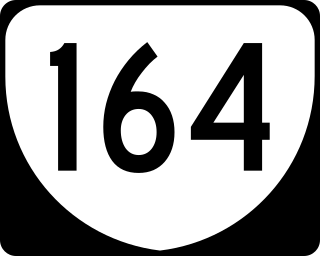
State Route 164 is a 7.27-mile-long (11.70 km) primary state highway in the U.S. state of Virginia that connects the northern parts of Suffolk and Portsmouth with Newport News and Hampton via Interstate 664 (I-664) with Downtown Portsmouth and Norfolk through either the Downtown or Midtown Tunnels.

State Route 337 is a primary state highway in the South Hampton Roads area of the U.S. state of Virginia. It runs east from Suffolk to Portsmouth, where it crosses Jordan Bridge. It continues on the east side of the Southern Branch Elizabeth River in the South Norfolk neighborhood of Chesapeake. There it turns north, through Norfolk, crossing the Berkley Bridge into downtown, and ending at the Naval Station Norfolk at Sewell's Point. Most of its length was formed when other highways were rerouted: U.S. Route 460 from Suffolk to South Norfolk, SR 170 from South Norfolk to downtown Norfolk, and US 17 from downtown Norfolk to Sewell's Point. SR 337 is the only numbered highway to cross all three Branches of the Elizabeth River. It crosses the Western Branch as Portsmouth Boulevard at the Hodges Ferry Bridge, the Southern Branch on the Jordan Bridge, and the Eastern Branch on the Berkley Bridge. The Berkley Bridge is a drawbridge. SR 337 also crosses the Lafayette River in the city of Norfolk.

Interstate 64 (I-64) in the US state of Virginia runs east–west through the middle of the state from West Virginia to the Hampton Roads region, for a total of 299 miles (481 km). It is notable for crossing the mouth of the harbor of Hampton Roads on the Hampton Roads Bridge–Tunnel (HRBT), the first bridge–tunnel to incorporate artificial islands, concurrent with U.S. Route 60 (US 60). Also noteworthy is a section through Rockfish Gap, a wind gap in the Blue Ridge Mountains, which was equipped with an innovative system of airport-style runway lighting embedded into the pavement to aid motorists during periods of poor visibility due to fog or other conditions.
The Hampton Roads Transportation Accountability Commission (HRTAC) is a political subdivision of the Commonwealth of Virginia in the United States that has the responsibility for funding several major traffic projects in the Hampton Roads area. It was created by the Virginia General Assembly in 2014 to maintain and administer the Hampton Roads Transportation Fund, a trust fund established by the Virginia General Assembly through a 0.7% increase in the state sales and use tax and a 2.1% increase in the fuel tax region-wide. The organization previously existed as the Hampton Roads Transportation Authority (HRTA) but was disbanded in 2008 after the Virginia Supreme Court invalidated its authority to raise and levy taxes.
Located in the southeastern corner of the state, Norfolk is economically and culturally important to Virginia. A variety of transportation modes have developed around the city's importance and somewhat unusual geography.
The Martin Luther King Freeway is a five-mile-long (8.0 km) stretch of U.S. Route 58 in the state of Virginia that connects State Route 164 and the Midtown Tunnel complex with midtown Portsmouth at London Boulevard, continuing past High Street near US 17 and ending at Interstate 264 (I-264) in a full interchange that opened on March 28, 2017.
Elizabeth River Crossings (ERC), officially known as Elizabeth River Crossings OpCo, LLC, is a limited liability company whose sole purpose is to finance, deliver, operate and maintain the Elizabeth River Tunnels Project in the South Hampton Roads region of Virginia. The project comprised the development, design, construction, finance and operation of a new two-lane tunnel adjacent to the existing Midtown Tunnel under the Elizabeth River, maintenance and safety improvements to the existing Midtown and Downtown tunnels, extending the Martin Luther King Freeway from London Boulevard to Interstate 264, and interchange modifications at Brambleton Avenue and Hampton Boulevard.
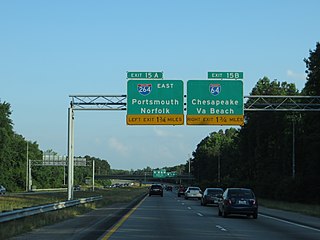
The Bowers Hill interchange is a large interchange complex where the Hampton Roads Beltway intersects with Interstate 264 (I-264) as well as Military Highway, which carries the three U.S. Highways. It is named for the unincorporated community surrounding it, Bowers Hill, Virginia, which itself is a part of the independent city of Chesapeake.
References
- 1 2 "Project History" (PDF). Virginia Department of Transportation. Retrieved March 30, 2015.
- ↑ "Average Daily Traffic Volumes with Vehicle Classification Data on Interstate, Arterial and Primary Roads" (PDF). Virginia Department of Transportation. 2013. Retrieved March 30, 2015.
- ↑ 2026 Regional Transportation Plan. Hampton Roads Planning District Commission. June 2004.
- ↑ "Hampton Roads 2026 Regional Transportation Plan Technical Document" (PDF). Hampton Roads Planning District Commission. June 2004. Retrieved March 31, 2015.
- ↑ "Toll Feasibility Study" (PDF). Hampton Roads Planning District Commission. October 28, 2005. Retrieved March 31, 2015.
- ↑ "Hampton Roads 2030 Long-Range Transportation Plan" (PDF). Hampton Roads Planning District Commission. March 21, 2007. Retrieved March 31, 2015.
- ↑ Marshall v Northern Virginia Transportation Authority, et al.(28 February 2008). Text
- ↑ "Request for Information" (PDF). Virginia Department of Transportation. November 1, 2004. Retrieved March 31, 2015.
- 1 2 "Parsons Transportation Group Statement of Interest" (PDF). Parsons Transportation Group. Retrieved March 31, 2015.
- ↑ "Parsons Transportation Group Statement of Interest" (PDF). Parsons Transportation Group. Retrieved March 31, 2015.
- 1 2 "Jacobs Statement of Interest" (PDF). Jacobs Civil. January 13, 2005. Retrieved March 31, 2015.
- ↑ "Solicitation For Conceptual Proposals Downtown Tunnel/Midtown Tunnel/MLK Extension Project through the Public-Private Transportation Act" (PDF). Virginia Department of Transportation. May 30, 2008. Retrieved March 30, 2015.
- 1 2 "VDOT Solicits Proposals for Midtown Tunnel and MLK Freeway Project" (PDF). May 31, 2009. Retrieved March 31, 2015.
- 1 2 "Public Private Transportation Conceptual Proposal Downtown Tunnel/Midtown Tunnel/MLK Extension Project" (PDF). Elizabeth River Crossings. Retrieved March 31, 2015.
- ↑ "Governor McDonnell Announces Contract to Build a Second Midtown Tunnel in Hampton Roads" (Press release). Virginia Department of Transportation. December 5, 2011. Archived from the original on April 2, 2015. Retrieved March 29, 2015.
- 1 2 "Comprehensive Agreement Relating to the Downtown Tunnel/Midtown Tunnel/Martin Luther King Freeway Extension Project Dated As Of December 5, 2011, by and Among Virginia Department of Transportation, an Agency of the Commonwealth of Virginia and Elizabeth River Crossings OpCo LLC, a Delaware limited liability company" (PDF). Elizabeth River Crossings OpCo. p. 152. Retrieved March 29, 2015.
- ↑ "Cost and Funding" (PDF). Elizabeth River Tunnels. February 4, 2014. Retrieved March 29, 2015.
- 1 2 "Gov. Mcdonnell Announces VDOT and ERC Reach Financial Close on Midtown Tunnel Project in Hampton Roads Region" (Press release). Virginia Department of Transportation. April 16, 2012. Archived from the original on April 8, 2015. Retrieved March 31, 2015.
- ↑ "S&P Rates to Elizabeth River Crossings 'BBB-". Reuters. April 12, 2012. Retrieved April 1, 2015.
- ↑ "Exhibit J to the Comprehensive Agreement: Toll Rate Schedule" (PDF). Elizabeth River Tunnels. December 5, 2011. Retrieved March 29, 2015.
- ↑ "Governor McAuliffe Announces Initial Toll Rates Will Be Cut in Half for the Downtown/Midtown Tunnels Project in Hampton Roads" (Press release). VDOT. January 15, 2014. Retrieved March 31, 2015.
- ↑ Walker, Julian (January 15, 2014). "Sources: Toll plan cuts rates to 75 cents, $1 - for now". The Virginian-Pilot. Retrieved March 29, 2015.
- ↑ "Frequently Asked Questions". Elizabeth River Tunnels. Retrieved March 29, 2015.
- ↑ "Exhibit J: Toll Rates Schedule" (PDF). Elizabeth River Tunnels. Retrieved March 29, 2015.
- ↑ "Downtown Tunnel gets roomier without ceiling panels". Virginian Pilot. March 5, 2011. Retrieved March 31, 2015.
- ↑ "Westbound Closures Scheduled for I-264 Downtown Tunnel Beginning August 9" (PDF) (Press release). Elizabeth River Crossings. July 31, 2013. Retrieved March 31, 2015.
- ↑ "Tunnel Rehabilitation FAQs" (Press release). Elizabeth River Crossings. Retrieved March 31, 2015.
- ↑ "City Council Resolution" (PDF). City of Portsmouth. October 8, 2013. Archived from the original (PDF) on February 19, 2015. Retrieved March 31, 2015.
- ↑ "Downtown Tunnel Weekend Closures: Analysis & Recommendation" (PDF). Elizabeth River Crossings. July 2013.
- ↑ Lebeau, Ariannee (September 10, 2014). "Changes Made to Downtown Tunnel West Closures". WVEC-TV. Archived from the original on April 2, 2015.
- ↑ "I-264 Westbound Downtown Tunnel to Close During The Nights Only" (Press release). Virginia Department of Transportation. October 23, 2013. Retrieved March 31, 2015.
- ↑ "Midtown Tunnel". Elizabeth River Tunnels. Retrieved March 29, 2015.
- ↑ "Midtown Tunnel". Elizabeth River Tunnels. Retrieved March 29, 2015.
- ↑ TEGNA. "One lane of new Midtown Tunnel to open Friday". WVEC. Retrieved June 17, 2016.
- ↑ "Interchange Justification Report for I-264/Martin Luther King Freeway" (PDF). Virginia Department of Transportation. June 2007. Retrieved March 31, 2015.
- ↑ "Operations and Maintenance of Downtown/Midtown Tunnels Is Formally Transferred to ERC" (PDF) (Press release). Elizabeth River Tunnels. July 13, 2012. Retrieved March 29, 2015.
- ↑ "Exhibit T to the Comprehensive Agreement: Turnover Plan" (PDF). Virginia Department of Transportation. Retrieved April 1, 2015.